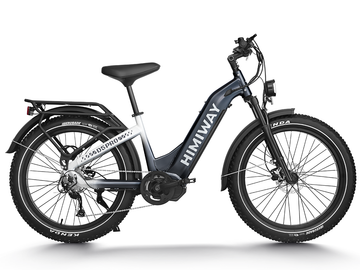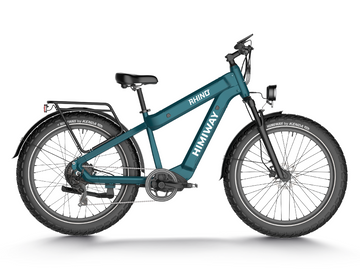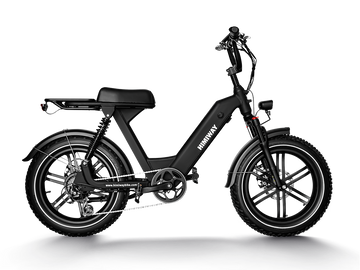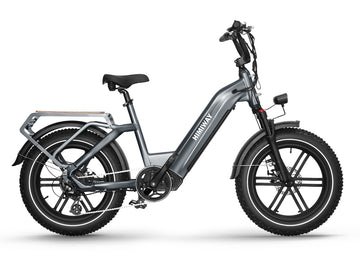Electric bike wheels are one of most essential components for your e-bike. The force you exert on the pedals, braking, road bumps and changes in direction are all related to the wheels. Wheels affect so many aspects, so the quality of them will definitely make a difference to your riding experience as well as riding safety.
If you plan to get an e-bike and don’t know much about the wheel, read on to find out the different types and sizes of e-bike wheel and how these differences can affect the right wheel for your needs.
Different Electric Bicycle Wheel
E-bike tires can be classified in terms of the type of terrain you ride on and your riding style. Based on that, here we roughly divide it into five condition categories.
Road Tire
Road tires are generally skinny, usually around 23 to 25 mm wide with light gross weight. The little tread and less surface area in contact with the road ensure less friction and higher speed when riding. They are suitable for riding on an asphalt surface. There is little pressure on the ground, and it is much easier to accelerate, which makes the rider feel lighter, so many people prefer to use road bikes. But on the other hand, these tires are more likely to be slippery in wet condition, so if the place you live rains or snows a lot, road tires might not be the best option.
Cyclocross Tire
Cyclocross tires are halfway between road tires and mountain tires. They are a bit wider than road tires, normally between 30 and 33 mm wide. The tires can be almost flat, with small patterns, or small studs for better grip on muddy surfaces. Cyclocross tires are a good choice for those who ride on gravel and muddy trails.

Commuting Bike Tire
People who ride bikes for daily commuting often ride on hard surfaces like asphalt or concrete. Being able to drive safely in wet conditions is a top priority. Commuting bike tires are designed for this type of riding, with flat, smooth and all-weather tread patterns. Most commuting bike tires have a width between 28mm and 42mm. Wider tires provide greater grip and comfort because they have more air volume and can reduce tire pressure.
Mountain Bike Tire
Unlike road bikes’ thin tires, mountain bikes are equipped with rigid, wide and fat tires. These tires have an aggressive tread that can grab the ground and gain maximum traction in harsh environments. That said, they suit for the one who does the majority of their riding off-road on surfaces like dirt, sand and grass. Plus, some mountain bike tires are made of natural rubber, which some believe grips the trail better than synthetics.
BMX Tire
BMX stands for bicycle motocross. It is the sport of racing specially built bicycles on a rough, cross-country course that includes constructed obstacles. Similar to mountain bike tires, BMX tires tend to be wider, chunky and knobby. Most BMX bikes have 20″ tires, while the larger frames may use 24″ tires. Different styles of BMX riding need different tread patterns and widths. A racing BMX uses a narrower tire with a high-level PSI whereas a freestyle BMX requires a wider BMX tire for grip with a higher than average PSI level for soft landings.

Electric Bicycle Wheel Size
Bicycle wheels come in various sizes from tiny 12-inch diameter to massive 29-inch diameter. Wheel size has an impact on the performance of e-bikes given that they determine the ease of bike movement, the degree of rolling and the smoothness of the ride. Check out the most common e-bike wheel sizes and their features below.
16-Inch E-bike Wheel
A 16-inch wheel is commonly found on a folding bicycle. Folding bicycles use smaller wheels to reduce weight and keep the folded size as compact as possible, thus allowing them to be easily transported. While accordingly, the small size sacrifices the quality of riding. They do not work well on rough or bump roads as they are easily affected by even small debris and rocks. Plus, small turning radius and wheelbase may result in too sensitive steering. Smaller wheels also require larger gear ratios to get them turning fast enough to keep up with other bikes, which makes hill climbs much more difficult.
20-Inch E-bike Wheel
Similarly, 20-inch wheels will also likely be found on a folding bike and are much more common than 16-inch wheels. They are also the standard for BMX tires due to their high quality of being maneuverable. However, for normal riders, wheels of this size still have some downsides, slightly better than 16 inches, 20-inch wheels are also easily affected by rocks and obstacles than larger standard wheel sizes.
26-Inch E-bike Wheel
With a long history in the bike industry, 26-inch wheels are probably the most common and popular wheel size and can be found on everything from mountain bikes to road bikes to beach cruisers. They tend to be wider and fatter, there is more air volume to disperse as you go over bumps, making the ride more comfortable. They are more suitable for mixed terrain, so if you are going on-road and off-road, go for 26-inch. The Himiway Cruiser and Step-Thru are equipped with 26-inch diameter wheels, and 20-inch diameter wheels for Himiway Escape, which all provide improved grip and traction on the most troublesome terrain.
29-Inch E-bike Wheel
29-inch-wheeled bikes came out a few years ago. They are larger in diameter with less rolling friction and more ground contact. More tire on the ground means better traction. And the biggest advantage of 29-inch is their ability to roll over obstacles on your path. It also takes less energy to maintain constant speed on larger wheels because they store their inertia better. Plus, 29-inch E-bikes have a higher standover height. So, if you're tall, this is a clear benefit, but for short riders (say 5’6’’ or shorter), it can be harder to fit in a 29-inch.
Apart from that, the flipside of big wheels also includes that large wheels weigh more, and a longer wheelbase results in reduced maneuverability, slower and less efficient acceleration than smaller wheels. Bigger wheels also transfer less torque to the ground for the same motor compared to smaller wheels.
How to Choose the Right Electric Bicycle Wheel
So all in all, how to choose the right electric bicycle tires, here are the key factors to consider:
Fat tires or thin tires?
Depending on the type, the bike has either fat tires or thin tires. If you are going to hit rough terrain, as well as paved roads, stick to fat tires. Thin tires are perfect for smooth roads.
Let's sum up the pros and cons of fat tires and thin tires.
Fat tires
Fat tires run at lower pressure with more traction and puncture protection, which allows the bike to work on a wider range of terrains. They are often found on mountain bikes and regular road bikes that are ridden on the tarmac, pavements, gravel, beaches and snow. However, the thickness of the tires has a certain effect on the speed of the bicycle, and can cause extra weight and increase rolling resistance. If you want to know more details about fat tires, check out this video.

Thin tires
On the contrary, thin tires use less rubber and are therefore lighter than fat tires. This makes it more efficient and easier to handle. They are perfect for smooth roads. With higher pressure, lower rolling resistance and lower traction, they can easily outpace the thicker ones in speed and agility. The drawback is that they have lower puncture protection and are not as sturdy as fat tires.
Size Matters
As we have discussed above, the size of the tires is vital. Bigger tires are likely be thicker. Smaller and thinner tires also come in different sizes. If you already own a bike, it certainly depends on the size of the frame you have. If you are an e-bike newcomer, then take some time to figure out your riding habits and buying accordingly.
If you think highly of maneuverability and portability, 16 or 20-inch wheels fit you well.
If riding comfort and speed efficiency are more important to you, then you should definitely choose the big wheels.
Choosing the right electric tires and wheels can spice up your riding experience. Hope this article can help you make the choice among the various wheel sizes and types. Ride safe and have fun!






































